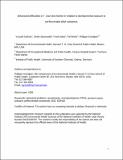| dc.description.abstract | Background: Perfluorinated alkyl substances (PFAS) are suspected endocrine disruptors that are highly persistent and neurotoxic in animals. Human epidemiological studies of exposure-related deviations of children’s behaviors are sparse. We assessed the associations between prenatal, 5- and 7- year PFAS exposures and behavioral problem scores in 7-year Faroese children.
Methods: Concentrations of perfluorooctanoic acid (PFOA), perfluorononanoic acid (PFNA), and perfluorodecanoic acid (PFDA), perfluorooctane sulfonate (PFOS), and perfluorohexane sulfonic acid (PFHxS) were measured in maternal serum and in serum from children at ages 5 and 7 years (n=539, 508, and 491, respectively). We used multivariable regressions and structural equations models to estimate the covariate-adjusted associations between serum-PFAS concentrations and behavioral difficulties, as assessed by the strengths and difficulties questionnaire (SDQ) at age 7.
Results: Serum-PFOS and PFHxS concentrations declined over time, whereas PFOA, PFNA, and PFDA tended to increase. No associations were observed between prenatal PFAS concentrations and SDQ scores. However, a two-fold increase in 5-year serum-PFOA, PFNA, and PFDA concentrations was associated with increases in total SDQ scores by 1.03 (95% CI: 0.11, 1.95), 0.72 (95% CI: 0.07, 1.38) and 0.78 points (95% CI: 0.01, 1.55), respectively. For SDQ subscales, significant associations were found in regard to hyperactivity, peer relationship, and conduct problems, as well as internalizing and externalizing problems and autism screening composite scores. Cross-sectional analyses at age 7 years showed possible sex-dimorphic associations between PFAS concentrations and SDQ scores, where girls had consistently positive associations with SDQ scores whereas boys exhibited a pattern of negative or null associations.
Conclusions: Higher serum PFAS concentrations at ages 5- and 7- years, but not prenatally, were associated with parent-reported behavioral problems at age 7. | en_US |


